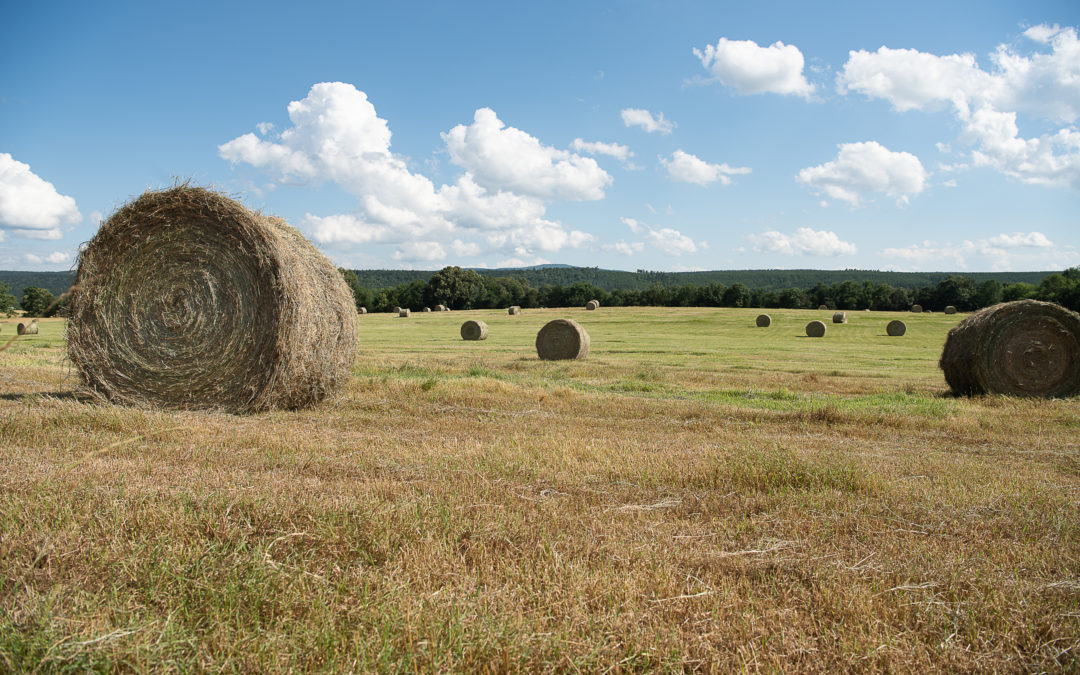For a cow-calf or stocker operation, hay has the potential to be the most valuable or the most expensive commodity that is fed for supplemental nutrition during the winter months. By avoiding these five common mistakes, you can ensure you get the maximum return for your investment.
1. “It made a lot of hay, so it has to be good.”
- It is a common misconception that the volume of hay produced is directly correlated to the nutrient quality of the hay. In reality, there is often an inverse relationship between tonnage produced from a field and the nutrient density of the hay. The majority of the nutrients in grasses are in the leaves rather than the stem. As grasses grow, the amount of leaf in relation to the number of stem decreases, which in turn reduces the overall nutrient density of the hay.
How to avoid this mistake:
-
-
- Take time to sample your hay and have a nutrient analysis performed. Many times, your feed company or local extension service will offer this service at little or no cost to you.
-
- Do not assume that just because you sampled your hay last year or on the field next to your other one that all the hay will be the same. It is very common to see nutrient quality variations from year to year on the same field due to changes in rainfall and temperature influencing growth patterns of the forage.
-
2. “I paid $40/bale for my hay.”
- It is common practice to purchase hay based on a $/bale price; however, depending on the true weight of each bale, this could result in a costly mistake.
- How to avoid this mistake:
-
- Purchase hay on a $/ton basis rather than a $/bale basis.
-
- Understand the relationship between bale size to approximate bale weight.
-
|
Relation of Round Bale Dimensions to Typical Bale Weight |
||
| Bale Width, ft | Bale Diameter, ft | Typical Bale Weight, lbs |
| 4 | 4 | 550 |
| 4 | 5 | 850 |
| 4 | 6 | 1,250 |
| 5 | 5 | 1,100 |
| 5 | 6 | 1,500 |
|
Relation of Square Bale Dimensions to Typical Bale Weight |
|||
| Bale Height, ft | Bale Width, ft | Bale Length, ft | Typical Bale Weight, lbs |
| 3 | 3 | 8 | 800 |
| 3 | 4 | 8 | 1,100 |
| 4 | 4 | 8 | 1,400 |
3.) “Just stack it over there.”
- Improperly stacking and storing hay can result in significant losses in consumable tonnage as well as nutrient degradation. Tonnage losses can reach up to 30% when hay is stacked outside in poorly drained areas.
- How to avoid this mistake:
-
- When possible, store hay in a barn or under a covered area.
-
- When stacking hay outside:
-
- Prepare an area that is well-drained by removing debris or excess standing forage.
-
- It is ideal to put down a base like gravel to insure quick drainage.
-
- Stack in rows with the flat side of the bales pushed together.
-
- Stack rows from top to bottom on southern-facing hills. This allows the water to run down between the rows of bales and allows sunlight on three sides of the row to promote drying.
-
- When stacking hay outside:
-
4.) “I feed my cows 30 lbs of hay per day.”
- It is common to hear producers say they feed their cows a prescribed amount of hay every day. The majority of producers develop their idea of what this amount should be based on their assumption of how much the cows need to eat; however, many rarely factor in the effects of hay waste on actual hay intake by the cow. This can result in overestimating nutrient delivery to the animal from the hay, sometimes significantly, which can result in reduced performance or body condition. Most hay waste at feeding is the result of animals standing, laying, and defecating on the hay.
- How to avoid this mistake:
-
- Understanding the factors that influence hay waste during feeding can help a producer better manage their losses.
-
| Hay Feeding Method | % Waste |
| No Ring | 35% |
| Hay Ring | 20% |
| Hay Conserver Ring | 8% |
| Unrolling | 15% |
| Grinding | 5% |
-
- Best Practices
-
- Feed on dry, firm ground.
-
- Feed only enough hay for one day.
-
- If feeding multiple days of hay use hay rings (preferably hay conserver rings).
-
- Rings with solid skirts work better than open rings.
-
- If feeding multiple days of hay use hay rings (preferably hay conserver rings).
-
- Allow 1 bale of hay to every 25 – 30 head.
-
- Best Practices
5.) “I ran out of hay, now what do I do.”
- Unfortunately, it is not uncommon to hear producers speak of running out of hay at the end of winter before their grass has started growing and having to make alternative, often expensive, plans to help cows until spring.
- How to avoid this mistake:
-
- Know how much hay you will need for your herd during periods of limited forage growth.
-
- If you find yourself short of hay in the fall, determine if your money is better spent by purchasing additional hay or planning to feed more feed to stretch the hay you have.
-
If going through these types of calculations is unfamiliar to a producer, it is best for them to find a trusted resource to help them in this process, whether that be through a consultant/nutritionist, your local extension service, or through a feed supplier.

Recent Comments